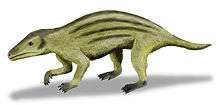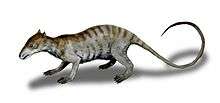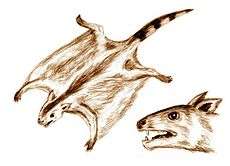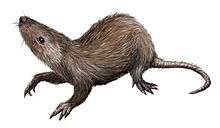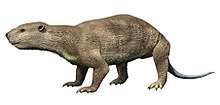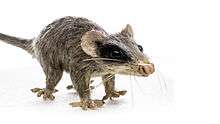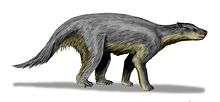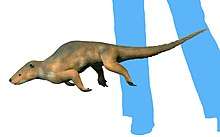Akidolestes
Akidolestes cifellii is a genus of spalacotheriid mammal preserved with a complete post-cranium and a partial skull has been discovered from the Yixian Formation of Liaoning, China.[1][2] The holotype of Akidolestes cifellii is reserved in Nanjing Institute of Geology and Palaeontology, Chinese Academy of Sciences.[1][2] The holotype has a complete skeleton with partial skull and dentition.[1][2] It is notable in that it displays characteristics of monotremes but appears to be more related to modern therian mammals.[1]
| Akidolestes cifellii | |
|---|---|
| Scientific classification | |
| Kingdom: | Animalia |
| Phylum: | Chordata |
| Class: | Mammalia |
| Order: | †Symmetrodonta |
| Family: | †Spalacotheriidae |
| Genus: | †Akidolestes Li & Luo, 2006 |
| Type species | |
| †Akidolestes cifellii Li & Luo, 2006 | |
Akidolestes has no modern relatives. It is an early offshoot of mammal related to therians (the subclass containing marsupials and placentals). It clearly belongs within a group of theriiform mammals known as the Spalacotherioidea. Unlike other members of this superfamily, however, Akidolestes has some very prototherian features.
The genus name, Akidolestes, is derived from akido, Greek for point, and lestes, Greek for thief. Akido- refers to the pointed snout and -lestes is a common suffix for fossil mammals. The specific epithet, cifelli, is in honor of Richard L. Cifelli, a prominent researcher in prehistoric mammals.[2]
Although it revealed some similar features to monotremes in the lumbar vertebrae, pelvis and hindlimb, Akidolestes cifellii is still placed in family Spalacotheriidae and close to Zhangheotherium and Maotherium.[2] Those convergent synapomorphies might from shared early common ancestor.[2] According to the analysis and comparison of anatomy and locomotory features about Akidolestes cifellii to its related taxon, there is a hypothesis that spalacotheroids might evolved earlier in Eurasia and then dispersed to North America, which is consistence with a common geo-dispersal patterns based on several mammalian groups during the Early Cretaceous period.[2]
Most fossils of Mesozoic mammals are reserved with teeth or jaw fragment only. Therefore, Akidolestes cifellii is the third spalacotheroid species discovered with a complete skeleton in the Yixian Formation after Zhangheotherium and Maotherium.[1]
Description
Dentition
The family Zhangheotheriidae and Spalacotheriidae form super family Spalacotheroidea.[1] Akidolestes cifellii has acute triangulation of the molar cusp pattern, which is the character belongs Spalacotheroids.[3] However, unlike to Maotherium with symmetrical premolar and molar pattern,[3] Akidolestes's premolars and molars are gradually longer, respectively.[2] Besides, Akidolestes has protocristid on the molars, which is different from Zhangheotherium and Maotherium.[2][3] The mandible of Akidolestes cifellii is similar to that of Zhangheotherium and Maotherium. They all have a coronoid process and dentary condyle.[2][3] In the same time, the structure and surface feature of Akidolestes's teeth is closer to spalacotheriids comparing with zhangheotheriids.[2] Overall, based on these dental characteristics, Akidolestes is put in the Spalacotheriidae.[2]
Post cranial skeleton
There are several features in Akidolestes cifellii that are similar to monotremes rather than common Mesozoic mammals.[2] In the original paper of Akidolestes cifellii, the author used Ornithorhynchus and Zhangheotherium as comparison with Akidolestescifellii. Zhangheotherium belongs to family Spalacotheriidae, and it is a Mesozoic mammals as well.[4] Ornithorhynchus is a living monotremes.[5]
On the pelvis, the epipubis of Akidolestes cifellii and ornithorhynchus is broad and triangular shape, but epipubis of Zhangheotherium is a narrow bone.[2] Besides, both Ornithorhynchus and Akidolestes have the tubercle for M. psoas minor muscle on pubis and tuber coxae on ilium, but those are absent in Zhangheotherium[2]. On the femur, Zhangheotherium has a symmetrical distal medial condyle and distal lateral condyle, but those condyles are more asymmetrical in both Akidolestes and Ornithorhynchus.[2] Moreover, comparing with Zhangheotherium, both Akidolestes and Ornithorhynchus has a shorter neck on the femur.[2] On the fibula and tibia, Akidolestes and Ornithorhynchus have hypertrophied parafibular process, proximolateral tuberosity of tibia and distal tibial malleolus, which are all absent in Zhangheotherium.[2]
Except pelvic girdle and hindlimbs, Akidolestes shares several features to living monotremes in forelimbs as well.[2] Similar to hindlimbs, Zhangheotherium has asymmetrical condyles on humerus, but the condyles of humerus on the Akidolestes and Ornithorhynchus are asymmetrical.[2] Additionally, Zhangheotherium and other Mesozoic mammals have a straight tibia, but the tibia on Akidolestes and Ornithorhynchus are more curved.[2] There is another striking feature of Akidolestes, which is distinguishable from other Mesozoic mammals, is the trochanter.[2] The trochanter on Zhangheotherium is bigger, tall and vertical, but the trochanter on Akidolestes is smaller, broader and with a triangular shape, which is similar to Ornithorhynchus.[2]
Paleobiology
Differences in post-cranial skeleton between Akidolestes cifellii and related taxa allow insights into the role of ecological differentiation in early therian mammal evolution.[1] Correlation between limb posture and locomotor function in Akidolestes cifellii indicates that the hypertrophied parafibular process on the fibula helps the flexed function of knee joint. A short neck on the femur and asymmetrical condyles on humerus indicate a horizontal orientation of the femur. Akidolestes probably had a parasagittal forelimb posture and most likely a semi-erect or sprawling posture for both forelimbs and hindlimbs.[1]
Akidolestes is not considered as a traditional terrestrial mammal like Zhangheotherium and Maotherium. Although there is a debate about if asymmetrical femoral condyles suggests Akidolestes is a terrestrial mammal or arboreal mammal.[1] In "Postcranial Skeleton of the Cretaceous Mammal Akidolestes cifellii and Its Locomotor Adaptations", the author argued that both Zhangheotherium and Maotherium are considered as terrestrial mammal, and they both have symmetrical knee joint.[1][4][6] Therefore, he preferred the hypothesis that asymmetrical femoral condyle is a feature for Akidolestes in arboreal habitats.[1] But, the hypertrophied parafibula on the fibula and medial malleolus on the tibia suggests Akidolestes is a terrestrial mammal.[1]
However, except limb posture, girdle is an important factor to infer the habitat preference of Akidolestes as well. On the pectoral girdle, Akidolestes has glenoid fossa smaller than humeral head, which offer a great range of rotation for humerus.[1] Moreover, Akidolestes has a scapula with triangular outline, which is similar to Ornithorhynchus and Haldanodon, but the scapula of Zhangheotherium is rectangular shaped.[1] Ornithorhynchus is a semifossorial and semiaquatic monotreme, and it can swim and burrow.[1] Haldanodon is a terrestrial mammal, and it is semifossorial and semiaquatic as well.[1] In the same time, the hook like and large coracoid process on the scapula make Akidolestes closer to arboreal mammal rather than terrestrial mammal.[1]
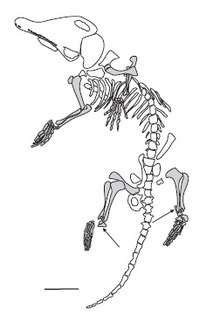
Overall, Akidolestes is a terrestrial mammal but not restricted to singular living habitats.[1]
Geology and Paleoenvironment
As mentioned in previous, Akidolestes cifellii was found from the Yixian Formation.[1][2] Yixian formation is one composition of Jehol Group.[7] Based on the Pan's Cretaceous Research, Jehol Group includes Huajiying Formation of northern Hebei to Yixian and Jiufotang Formations of western Liaoning.[7] Besides, in order to distinguish from other formation in the Jehol Group, the Yixian formation is characterized by volcanic rocks.[7][8] Yixian lacustrine beds at the Dawangzhangzi Locality, Lingyuan, Liaoning, China.[9] Yixian formation is dated to be Berriasian (140.2myr-145.5myr) in Lower Cretaceous of the Jehol Biota.[2][7][8] Yixian stratum is correlated with other localities including Jingangshan Locality, Jianshangou Locality and Lujiatun Locality.[9] Other mammals of the Yixian Formation include eutriconodontans, multituberculates, symmetrodonts, metatherians and eutherians.[2]
Classification
Akidolestes cifellii and Spalacotherium are sister taxon, and share the common ancestor with Zhangheotherium, the clade contains these three species is Spalacotheroidea within the Trechnotherian group.[1][2] Theria clade includes Metatheria and Eutheria, which is the outgroup of Spalacotheroidea.[10] Theriiformes includes Theria and Spalacotheroidea.[2][10] (Cladogram doesn't perfectly contain all important details due by technical issue.) The cladogram is based on the content from "Evolution of the patellar sesamoid bone in mammals",[10] "A cretaceous symmetrodont therian with some monotreme-like postcranial features",[2] "Classification of Mammals Above the species Level".[11]
| |||||||||||||||||||||||||||||||||||||
References
- Chen, Meng; Luo, Zhe-Xi (2012-04-20). "Postcranial Skeleton of the Cretaceous Mammal Akidolestes cifellii and Its Locomotor Adaptations". Journal of Mammalian Evolution. 20 (3): 159–189. doi:10.1007/s10914-012-9199-9. ISSN 1064-7554.
- Li, Gang; Luo, Zhe-Xi (2006-01-12). "A Cretaceous symmetrodont therian with some monotreme-like postcranial features". Nature. 439 (7073): 195–200. doi:10.1038/nature04168. ISSN 1476-4687. PMID 16407951.
- Ji, Qiang; Luo, Zhe-Xi; Zhang, Xingliao; Yuan, Chong-Xi; Xu, Li (2009-10-09). "Evolutionary Development of the Middle Ear in Mesozoic Therian Mammals" (PDF). Science. 326 (5950): 278–281. doi:10.1126/science.1178501. ISSN 0036-8075. PMID 19815774.
- Hu, Yaoming; Wang, Yuanqing; Luo, Zhexi; Li, Chuankui (1997). "A new symmetrodont mammal from China and its implications for mammalian evolution". Nature. 390 (6656): 137–142. doi:10.1038/36505. ISSN 0028-0836. PMID 9367151.
- Whittington, Camilla M.; Belov, Katherine (2014-04-02). "Tracing Monotreme Venom Evolution in the Genomics Era". Toxins. 6 (4): 1260–1273. doi:10.3390/toxins6041260. PMC 4014732. PMID 24699339.
- ROUGIER, Guillermo W.; Qiang, JI; NOVACEK, Michael J. (2010-09-07). "A New Symmetrodont Mammal with Fur Impressions from the Mesozoic of China". Acta Geologica Sinica - English Edition. 77 (1): 7–14. doi:10.1111/j.1755-6724.2003.tb00104.x. ISSN 1000-9515.
- Pan, Yanhong; Sha, Jingeng; Zhou, Zhonghe; Fürsich, Franz T. (2013). "The Jehol Biota: Definition and distribution of exceptionally preserved relicts of a continental Early Cretaceous ecosystem". Cretaceous Research. 44: 30–38. doi:10.1016/j.cretres.2013.03.007. ISSN 0195-6671.
- Barrett, Paul M. (2000). "Evolutionary consequences of dating the Yixian Formation". Trends in Ecology & Evolution. 15 (3): 99–103. doi:10.1016/s0169-5347(99)01782-6. ISSN 0169-5347.
- Zhongguo Liao xi zhong sheng dai Rehe sheng wu qun. Ji, Qiang., 季強. (Beijing di 1 ban ed.). Beijing: Di zhi chu ban she. 2004. ISBN 7116040455. OCLC 56941129.CS1 maint: others (link)
- Samuels, Mark E.; Regnault, Sophie; Hutchinson, John R. (2017-03-21). "Evolution of the patellar sesamoid bone in mammals". PeerJ. 5: e3103. doi:10.7717/peerj.3103. PMC 5363259. PMID 28344905.
- C., McKenna, Malcolm (1997). Classification of mammals above the species level. Bell, Susan K., Simpson, George Gaylord, 1902-1984. New York: Columbia University Press. ISBN 023111012X. OCLC 37345734.

